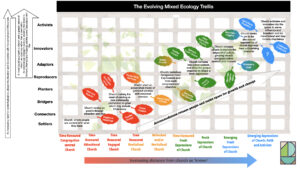It’s that season where newspapers tell us stuff we already knew and there is a subsequent flurry of activity in faith based circles. This time is was The Times telling us Britain is no longer a Christian country, say frontline clergy. The article is behind a paywall but a summary with a couple of links is HERE.
In the accompanying flurry of radio interviews, articles and comments much attention is paid to How things are done and depending on your perspective, the same old arguments about the how get rolled out. Now Im starting to sound grumpy mainly because entrenchment gets us nowhere. Perhaps one way forward is to think why are we in these trenches in the first place and I think that much of it is do with the Epistemology and Ontological approaches to church and faith and truth that I discussed in the previous post. Language is going to fail me so Im going to play with metaphor to try and find a more spacious way forward.
In one trench you have epistemology and we wave the flag of Jesus the Rock. Here we know what Jesus looks like, and like a rock it never changes. They are steadfast, predictable, weighable, and known, and when we look we see the security and shelter on offer. The truth is at hand but it’s held closed.*
In the other trench is ontology and we wave the flag of Jesus the Person. Someone like anyone who grows, eats, drinks and someone who learns and changes. They are prone to unpredictable stories, and when we look into their eyes we see we are all on a journey to the deep unknown. The truth is at hand and it’s held with and open palm*.
And like in wars of old, neither side makes any progress whilst the world looks on unable to comprehend why either side is so dug in the first place. But between them is a field a space where grace and love can model something else to the world. Its hard to imagine, impossible to describe but the deeper magic that rises up as each side climb out of their trenches, kick a ball around, exchange gifts and really encounter one another, yet it is something of beauty that the whole world recognises, longs for and is drawn towards.
Like the temporary Christmas truces during the war we catch these glimpses of beauty. These glimpses are fleeting because not because we resist change but because we resist loss and when you’re dealing with something as fundamental as the nature of truth people feel they have an awful lot to loose. Yet we know these grace spaces when we see it, we catch these thin places out of the corners of eye, they serve as new banner to rally under but for something for lasting to be embraced we will need to clamber out the sides of those muddy trenches, take the risk of those first hard yards towards the other. Falteringly step beyond the graves of heroes of bygone eras and enter the grace space. But to stay there we will need to let the grace space invade our very being, and do the soul work that these genuine encounters demand until we learn that neither truth needs the upper hand, and the kin-dom is so much more we can imagine.
*See Graham Adams Holy Anarchy “Truth-in-Hand. Grasped. Contained. Sufficient” p38 “Truth-in-Process. truth as event, conversation, an ecology of potential, attentiveness, the making possible of greater empathy.” p39

